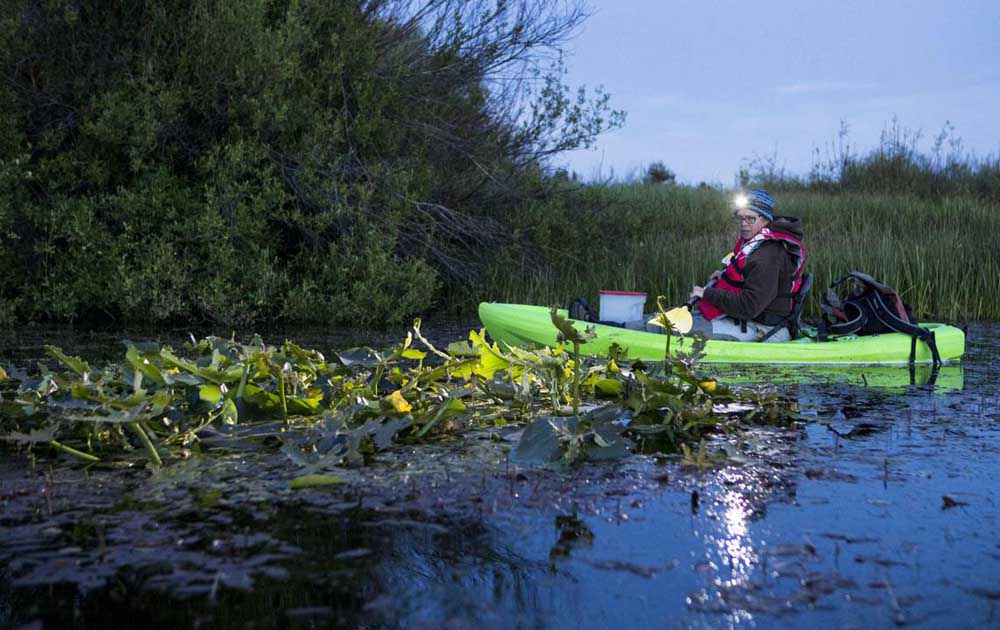Conservationist protects Oregon spotted frog
Published 12:38 pm Wednesday, June 24, 2020

- Jodi Wilmoth uses her headlamp to scan the water surface for bullfrogs while working on removing the invasive species from a marshy area at Thousand Trails Campground in Sunriver last week.
Ten years ago, Jodi Wilmoth was captaining yachts and vintage boats in Alaska. Today she is at the forefront of conservation activities to support the Oregon spotted frog.
Wilmoth’s varied career — from naturalist and boat captain to the pharmaceutical industry and now wildlife conservation — has landed her most recently in Sunriver, where she spends her summers trying to protect the threatened Oregon spotted frog by removing one of its major competitors: bullfrogs, which are not native to Oregon. The bullfrogs are taken by the thousands, and the project continues indefinitely.
Bullfrogs, also called American bullfrogs, were introduced to Oregon more than a century ago, and they have since proliferated in the state. These large frogs, which measure up to 8 inches across when fully grown, come primarily from east of the Rockies and favor the southeastern part of the U.S. They were introduced to Oregon as a food item — their legs were once considered a delicacy.
Since their introduction to this state, a battle for supremacy has raged in Oregon’s frog habitats, and the bullfrog has largely outcompeted the native spotted frog. Bullfrogs take food resources away from the spotted frogs and occupy the prime living and breeding habitats. When confrontations occur, bullfrogs will even eat the spotted frogs and can devour several dozen annually. They are also prolific breeders — a female can lay up to 20,000 eggs in one summer.
Bullfrogs are one reason why the Oregon spotted frog was listed as threatened under the Endangered Species Act in 2014.
The spotted frog, which measures around 2 to 4 inches across, has other threats too, including habitat loss and environmental changes caused by dams and agriculture. More water is now released from Wickiup Dam in winter to help support spotted frog populations, but reducing bullfrog populations in the Upper Deschutes is also an important task in helping to support the native frog species.
So Wilmoth and a team of volunteers now catch bullfrogs, mostly at night. In darkness she hunts the frogs, using nets and her bare hands, in areas around Sunriver. In 2017 her control program captured over 5,000 bullfrogs in Lake Aspen, located near the Sunriver Nature Center. The bullfrogs are still there, but rarely seen these days.
“We are giving the Oregon spotted frog a chance to get those resources, get that food and also have a major invasive predator removed,” said Wilmoth. “So hopefully we are going to see even better numbers of Oregon spotted frogs as we continue to keep the bullfrogs under control in those areas.”
She warns that recovery of the Oregon spotted frog is expected to take time and resources.
“Only with continued effort in invasive species control, protections and habitat conservation will we start to see the recovery of the Oregon spotted frog,” said Wilmoth. “We will need patience and time to see the results.”
In addition to the frog habitats in Sunriver, Wilmoth also conducts bullfrog control programs at Vandevert Ranch and Thousand Trails Campground, both in the Upper Deschutes River basin. Her projects are funded and supported by the Oregon Watershed and Enhancement Board, the Sunriver Homeowners Association and Sunriver Resort.
Wilmoth fell into bullfrog control, and Oregon spotted frog support, following a career that took her from Oregon and Washington state to Alaska and back to Oregon. She grew up in Christmas Valley, studied molecular biology at Pacific Lutheran University in Washington, and then traveled to Alaska to work as a naturalist and fly fishing guide.
Along the way, Wilmoth earned a license to pilot large marine vessels of up to 200 tons. She used the license to drive yachts and other boats, including a vintage minesweeper from the 1940s, in order to shuttle tourists around Glacier Bay National Park.
After 10 years in Alaska, Wilmoth grew weary of seasonal work and moved back to the Pacific Northwest where she started down a new career in the pharmaceutical industry doing project management and research. Her love of biology eventually led to volunteering for conservation projects — Portland-based Campbell Environmental hired her to work on the bullfrog control program in Sunriver.
The work allows Wilmoth to use the wilderness skills she perfected in Alaska, including kayaking, to reach bullfrog habitats. In the field, she removes bullfrog egg masses, traps tadpoles and captures the juvenile and adult bullfrogs. Most people are interested in hearing about the trapping of adult bullfrogs, she said.
“We go out at night because that is when we can see their bullfrog’s eyes shine in the headlamps. They are easy to spot,” she said. “Also when we have our headlamps on, they can’t see us, they can only see the light. So we can get very close to them.”
Once captured, Wilmoth keeps the frogs in Tupperware containers on her kayak before heading ashore.
Unfortunately for the bullfrogs, they are put down with a chemical agent, and then frozen. Some are given to researchers to dissect and the rest are put in a compost heap. Those bullfrogs that aren’t captured hibernate for the winter in the mud, only to appear again in spring.
A year ago Wilmoth removed from Vandevert Ranch almost 50 egg masses, which contained around 1 million bullfrog eggs. In 2018 she removed 14,000 bullfrog tadpoles from the Thousand Trails Campground area.
Wilmoth says the mission to keep the Upper Deschutes free of bullfrogs is ongoing, and she does not expect a full eradication from the area, as the amphibians will continue to arrive from upstream areas. But she is excited to teach children and adults about her program so as to keep the public aware that more work needs to be done.
At Thousand Trails Campground, Wilmoth educates children in small classes about the invasive bullfrog and the native Oregon spotted frog. Some of them spend the rest of the day looking for bullfrogs for her.
Is it legal for members of the public trap and eliminate bullfrogs on their own?
Wilmoth says this is possible, and Oregon Department of Fish and Wildlife does not require a license to catch bullfrogs. She advises the public to educate themselves on the difference between bullfrogs and Oregon spotted frogs, to avoid capturing the wrong creature. She reminds people that Oregon spotted frogs are protected by law, and there are penalties for harming a threatened species.
The other question that may arise is whether the bullfrogs can be saved and released somewhere else. Wilmoth says no, explaining that since they are not native to Oregon, they can have devastating impacts on all frog habitat in this state.
“They are dangerous to all ecosystems that they inhabit,” said Wilmoth. “So unless I want to put them on a plane and ship them to Mississippi, there is no re-releasing these frogs. They are not supposed to be here.”





